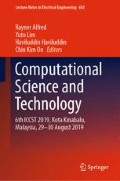Abstract
Context recognition plays an important role in connecting the space between high-level applications and low-level sensors. To recognize human context, various kinds of sensors have been adopted. Among the variety of exploited sensors, smartphone internal sensors such as accelerometer and gyroscope are widely used due to convenience, non-intrusiveness and low deployment cost. Automatic detection of driver’s context is a very crucial factor to determine the driver’s behaviors. This paper proposes an approach to recognize driver’s context which is a very specific research direction in the domain of human context recognition. The objective of this approach is to automatically detect the contexts of drivers using a smartphone’s internal sensors. The proposed algorithm explores the power of a smartphone’s built-in accelerometer and gyroscope sensors to automatically recognize the driver’s context. Supervised machine learning k-nearest neighbor is employed in the proposed algorithm. Empirical results validated the efficiency of the proposed algorithm.
Access this chapter
Tax calculation will be finalised at checkout
Purchases are for personal use only
Preview
Unable to display preview. Download preview PDF.
References
Minh, T., T. Do, Blom, J., and Gatica-Perez, D., “Smartphone Usage in the Wild : a Large-Scale Analysis of Applications and Context,” icmi, 2011.
Milette, G. and Stroud, A. Stroud, Professional android sensor programming. John Wiley & Sons, 2012.
Guo, B., Zhang, D., Wang, Z., Yu, Z., and Zhou, X., “Opportunistic IoT: Exploring the harmonious interaction between human and the internet of things,” J. Netw. Comput. Appl., 2013.
Wang, A., Chen, G., Yang, J., Zhao, S., and Chang, C.-Y., “A Comparative Study on Human Activity Recognition Using Inertial Sensors in a Smartphone,” IEEE Sens. J., vol. 16, no. 11, pp. 4566–4578, Jun. 2016.
Otebolaku, A. M. and Andrade, M. T., “User context recognition using smartphone sensors and classification models,” J. Netw. Comput. Appl., vol. 66, pp. 33–51, May 2016.
Braunagel, C., Kasneci, E., Stolzmann, W., and Rosenstiel, W., “Driver-Activity Recognition in the Context of Conditionally Autonomous Driving,” in 2015 IEEE 18th International Conference on Intelligent Transportation Systems, 2015, pp. 1652–1657.
Hossen, M. I., Goh, M., Connie, T., Aris, A., and Pei, W. L., A Review on Outdoor Parking Systems Using Feasibility of Mobile Sensors, vol. 488. 2018.
Demissie, M. G., “Traffic Volume Estimation Through Cellular,” no. July, pp. 1–16, 2013.
Randell, C. and Muller, H., “Context-awareness by analyzing accelerometer data,” 2002.
Nurhanim, K., Elamvazuthi, I., Izhar, L. I., and Ganesan, T., “Classification of human activity based on smartphone inertial sensor using support vector machine,” in 2017 IEEE 3rd International Symposium in Robotics and Manufacturing Automation (ROMA), 2017, pp. 1–5.
Tao, D., Wen, Y., and Hong, R., “Multicolumn Bidirectional Long Short-Term Memory for Mobile Devices-Based Human Activity Recognition,” IEEE Internet Things J., 2016.
Ustev, Y. E., Durmaz Incel, O., and Ersoy, C., “User, device and orientation independent human activity recognition on mobile phones,” 2013.
Xiuju Fu and Lipo Wang, “Data dimensionality reduction with application to simplifying rbf network structure and improving classification performance,” IEEE Trans. Syst. Man Cybern. Part B, vol. 33, no. 3, pp. 399–409, Jun. 2003.
Ezghari, S., Zahi, A., and Zenkouar, K., “A new nearest neighbor classification method based on fuzzy set theory and aggregation operators,” Expert Syst. Appl., vol. 80, pp. 58–74, Sep. 2017.
D’Angelo, G., Rampone, S., and Palmieri, F., “Developing a trust model for pervasive computing based on Apriori association rules learning and Bayesian classification,” Soft Comput., vol. 21, no. 21, pp. 6297–6315, Nov. 2017.
Hossen, M. I., Goh, M., Lau, S. H., and Bari, A., “Smartphone-Based Drivers Context Recognition,” KES Smart Innov. Syst. Technol., 2019.
(Vojislav) Kecman, V., Learning and soft computing : support vector machines, neural networks, and fuzzy logic models. MIT Press, 2001.
Sukumar, P. and Gnanamurthy, R. K., “Computer Aided Detection of Cervical Cancer Using Pap Smear Images Based on Adaptive Neuro Fuzzy Inference System Classifier,” J. Med. Imaging Heal. Informatics, 2016.
Lipo Wang and Lipo, “On competitive learning,” IEEE Trans. Neural Networks, vol. 8, no. 5, pp. 1214–1217, 1997.
Zurada, J. M., “Data mining with computational intelligence,” IEEE Transactions on Neural Networks. 2006.
Liu, B., Wan, C., and Wang, L., “An efficient semi-unsupervised gene selection method via spectral biclustering,” IEEE Trans. Nanobioscience, 2006.
Author information
Authors and Affiliations
Corresponding author
Editor information
Editors and Affiliations
Rights and permissions
Copyright information
© 2020 Springer Nature Singapore Pte Ltd.
About this paper
Cite this paper
Hossen, M.I., Goh, M., Connie, T., Lau, S.H., Bari, A. (2020). An Automated Driver’s Context Recognition Approach Using Smartphone Embedded Sensors. In: Alfred, R., Lim, Y., Haviluddin, H., On, C. (eds) Computational Science and Technology. Lecture Notes in Electrical Engineering, vol 603. Springer, Singapore. https://doi.org/10.1007/978-981-15-0058-9_11
Download citation
DOI: https://doi.org/10.1007/978-981-15-0058-9_11
Publisher Name: Springer, Singapore
Print ISBN: 978-981-15-0057-2
Online ISBN: 978-981-15-0058-9
eBook Packages: EngineeringEngineering (R0)

